How is the Image Formed by a Spherical Mirror?
Image formation by Spherical mirror in different cases
Introduction: From mirror formula, we find that for a mirror of a fixed focal length f, as object distance u changes, image distance n also changes.
Image Formed by Concave mirror
- Object at Infinity
A point object lying on the principal axis. Rays come parallel to the principal axis and after reflection from the mirror actually meet at the focus F.
The image is formed at F. It is real and point sized (fig.)
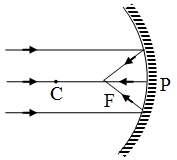 Fig. Concave mirror: point object at infinity, image at focus.
Fig. Concave mirror: point object at infinity, image at focus. - Object Beyond Centre of Curvature
Real object AB has its image A’B’ formed between focus and centre of curvature. The image is real-inverted and diminished.
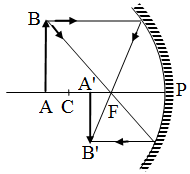 Fig. Concave mirror: object beyond centre of curvature, image between focus and centre of curvature.
Fig. Concave mirror: object beyond centre of curvature, image between focus and centre of curvature. - Object at Centre of Curvature
Real object AB, has its image A’B’ formed at centre of curvature.
The image is real-inverted and has same size as the object. (fig.).
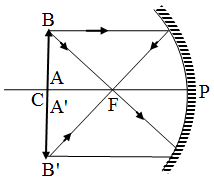 Fig. Concave mirror: object at centre of curvature, image at centre of curvature
Fig. Concave mirror: object at centre of curvature, image at centre of curvature - Object between Centre of Curvature and Focus
Real object AB has its image A’B’ formed beyond centre of curvature.
The image is real-inverted and enlarged (bigger in size than the object). (Fig.)
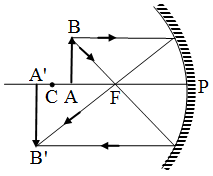 Fig. Concave mirror: object between centre of curvature and focus, image beyond centre of curvature.
Fig. Concave mirror: object between centre of curvature and focus, image beyond centre of curvature. - Object at Focus
Real object AB has its image formed at infinity.
The image is imaginary inverted (reflected rays go downward) and must have very large size.
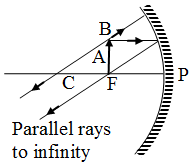 Fig. Concave mirror: object at focus image at infinity.
Fig. Concave mirror: object at focus image at infinity. - Object between Focus and Pole
Real object AB has its image A¢B¢ formed behind the mirror. The image is virtual-erect and enlarged.
 Fig. Concave mirror: Object between pole and focus, image behind the mirror.
Fig. Concave mirror: Object between pole and focus, image behind the mirror.
People also ask
- What is Reflection of Light?
- What is the Law of Reflection of Light?
- Application of Reflection of Light in Daily Life
- What do you mean by Total Internal Reflection?
- Applications of Total Internal Reflection
- Image Reflection by a Plane Mirror
- Which Type of Image is Formed by a Plane Mirror?
- Is an Image formed by Reflection Real or Virtual
- Reflection of Light from Spherical Mirror
- What are Concave and Convex Mirrors?
- How is Focal Length related to Radius of Curvature?
Image Formed by By convex mirror
- Object at infinity
A point object lying on the principal axis.
Rays come parallel to the principal axis and after reflection from the mirror, appear to diverge from focus F behind the mirror.
The image is formed at F.
The image is virtual and point sized. [fig.]
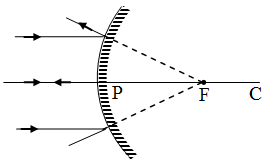 Fig. Convex mirror: point object at infinity, virtual image at focus.
Fig. Convex mirror: point object at infinity, virtual image at focus. - Object at anywhere on principle axis
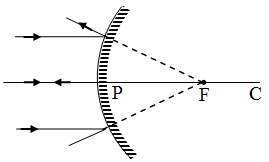 Image is virtual & point sized.
Image is virtual & point sized.
Characteristics of the Image Formed by a Concave Mirror
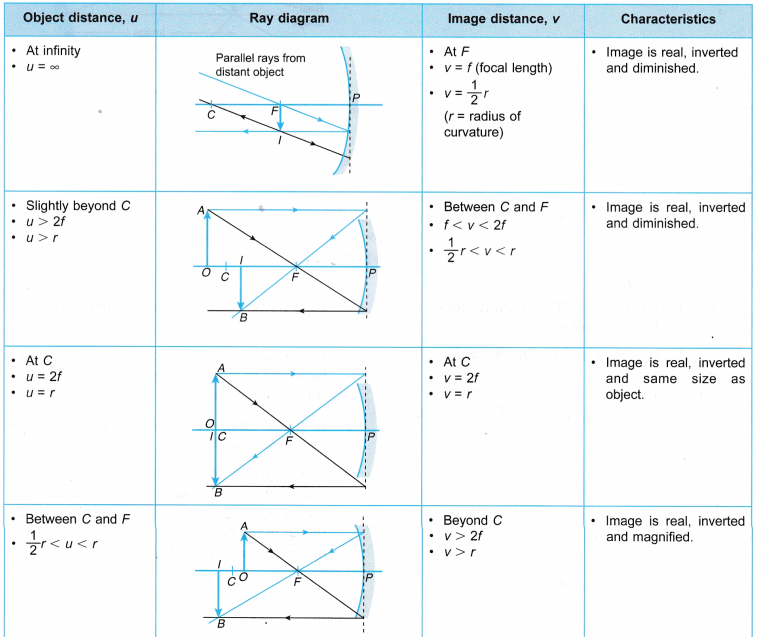

Characteristics of the Image Formed by a Convex Mirror
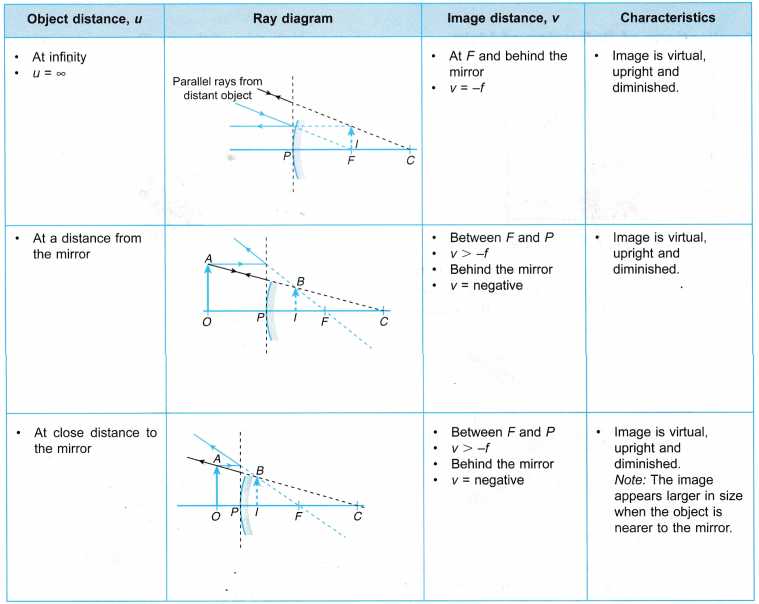
Image Formed by a Spherical Mirror Experiment
Aim: To study the nature of images formed by convex and concave mirrors.
Materials needed: Concave mirror, convex mirror, a sheet of white paper, a well-lit window, and
adhesive tape.
Method:
For concave mirror
- Take the sheet of white paper and fold it about two or three times to make a screen.
- Stick the screen (folded paper) on the window grill of an open window.
- Take the concave mirror and hold it facing the window (and the screen).
- Move it back and forth till you get a clear image of the objects outside the window (such as leaves, trees, and sky) on the screen.
- Note down your observations for the following questions:
(a) Is it a real or a virtual image?
(b) Is the image inverted or upright?
(c) Is the image smaller or bigger than the object? - Look at yourself in the concave mirror and move the mirror forward and backward.
Note down your observations for the following questions:
(a) Is the image inverted or upright?
(b) Is the image upright when the mirror is closer to your face or farther away?
(c) Is the image of your face (when it is upright) smaller or bigger than your face?
(d) Is the image of your face (when it is inverted) smaller or bigger than your face? - Repeat the same procedure using a convex mirror and record your observations.
